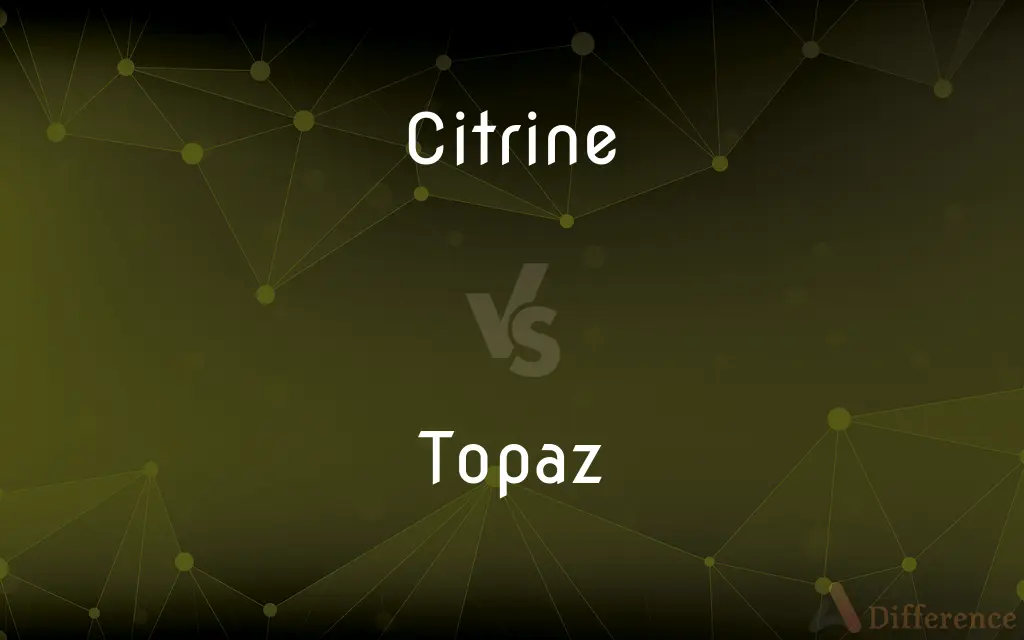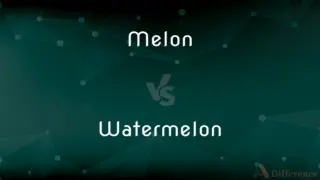Citrine vs. Topaz — What's the Difference?
By Tayyaba Rehman & Maham Liaqat — Updated on March 17, 2024
Citrine, a variety of quartz, is known for its yellow to brownish-orange hues, symbolizing warmth and energy. Topaz, a silicate mineral, comes in various colors but is famed for its blue and yellow varieties, symbolizing affection and strength.

Difference Between Citrine and Topaz
Table of Contents
ADVERTISEMENT
Key Differences
Citrine and topaz are both popular gemstones in jewelry making, but they differ significantly in composition, color range, and symbolism. On the other hand, topaz is a silicate mineral of aluminum and fluorine, known for its hardness and high refractive index, which gives it a brilliant shine. Topaz occurs in a wide range of colors, including blue, yellow, pink, red, and clear. Its most prized color variety, imperial topaz, exhibits a vibrant orange with pink undertones.
The origins of citrine are often linked to volcanic regions or geothermal areas, where the high temperatures contribute to its formation. Meanwhile, topaz is typically found in pegmatite deposits or as water-worn pebbles in stream sediments. This difference in geological formation reflects the diverse environments in which these gemstones are created.
Citrine is sometimes referred to as "the merchant's stone" due to beliefs in its ability to bring prosperity and success. It is also thought to promote creativity and encourage fullness of life. Topaz is traditionally associated with strength and intelligence, believed to provide the wearer with protection and the ability to make wise decisions. Furthermore, topaz is the birthstone for November, sharing this month with citrine, which often leads to confusion between the two.
From a durability standpoint, topaz is harder than citrine, scoring an 8 on the Mohs scale of mineral hardness, compared to citrine's score of 7. However, both stones require care in handling and wearing due to their cleavage properties, which can make them prone to splitting.
The visual similarities between yellow varieties of citrine and topaz can make differentiation challenging for the untrained eye. However, gemologists and knowledgeable jewelers can distinguish between them based on their physical and optical properties, such as hardness, density, and refractive index.
ADVERTISEMENT
Understanding the differences between citrine and topaz is important for collectors, jewelers, and enthusiasts alike, ensuring the accurate identification and appreciation of these beautiful gemstones.
Comparison Chart
Composition
Silicon dioxide (quartz)
Aluminum silicate fluoride hydroxide
Color Range
Yellow to brownish-orange
Wide range, including blue, yellow, pink, and imperial
Symbolism
Vitality, prosperity, creativity
Strength, intelligence, protection
Hardness (Mohs)
7
8
Origins
Volcanic regions, geothermal areas
Pegmatite deposits, stream sediments
Notable Varieties
Natural citrine, heated amethyst
Imperial topaz, blue topaz
Compare with Definitions
Citrine
Often heat-treated amethyst.
Much of the citrine on the market is actually heat-treated amethyst, giving it its vibrant color.
Topaz
A silicate mineral available in various colors.
The blue topaz earrings were a striking contrast to her evening gown.
Citrine
Symbolizes prosperity and creativity.
Artists often wear citrine to enhance creativity and success.
Topaz
Birthstone for November.
As a November birthday gift, she received a beautiful topaz pendant.
Citrine
Known for its affordability and warmth.
She chose citrine for her engagement ring for its warm, sunny energy.
Topaz
Includes varieties like imperial and blue topaz.
Imperial topaz, with its vibrant orange-pink hue, is highly sought after by collectors.
Citrine
Popular in both modern and antique jewelry.
The antique citrine brooch was a cherished heirloom, passed down through generations.
Topaz
Prized for its brilliance and hardness.
Topaz is a favorite for everyday jewelry because of its durability and shine.
Citrine
A yellow to brownish-orange quartz.
The citrine necklace sparkled in the sunlight, its golden hues captivating.
Topaz
Associated with strength and wisdom.
He wore a topaz ring as a symbol of strength and protection.
Citrine
A pale yellow variety of crystalline quartz resembling topaz.
Topaz
Topaz ( TOH-paz) is a silicate mineral of aluminium and fluorine with the chemical formula Al2SiO4(F, OH)2. It is used as a gemstone in jewelry and other adornments.
Citrine
A light to moderate olive.
Topaz
A precious stone, typically colourless, yellow, or pale blue, consisting of an aluminium silicate that contains fluorine.
Citrine
A goldish-yellow colour, like that of a lemon.
Topaz
A large tropical American hummingbird with a yellowish throat and a long tail.
Citrine
A brownish-yellow quartz.
Topaz
A colorless, blue, yellow, brown, or pink aluminum silicate mineral, often found in association with granitic rocks and valued as a gemstone.
Citrine
Of a goldish-yellow colour.
Topaz
Any of various yellow gemstones, especially a yellow variety of sapphire or corundum.
Citrine
Like a citron or lemon; of a lemon color; greenish yellow.
Topaz
A light yellow variety of quartz.
Citrine
A yellow, pellucid variety of quartz.
Topaz
A silicate mineral of aluminium and fluorine, usually tinted by impurities.
Citrine
Semiprecious yellow quartz resembling topaz
Topaz
An often clear, yellowish-brown gemstone cut from this.
Topaz
A yellowish-brown color, like that of the gemstone.
Topaz
A black Catholic soldier in the British Army.
Topaz
Either of two species of very large hummingbirds in the genus Topaza.
Topaz
A ruby-topaz hummingbird, Chrysolampis mosquitus, the male of which has bright ruby feathers on the head and topaz on the throat
Topaz
Of a yellowish-brown color, like that of the gemstone.
Topaz
A mineral occurring in rhombic prisms, generally yellowish and pellucid, also colorless, and of greenesh, bluish, or brownish shades. It sometimes occurs massive and opaque. It is a fluosilicate of alumina, and is used as a gem.
Topaz
Either one of two species of large, brilliantly colored humming birds of the genus Topaza (Topaza pella or Topaza pyra), of South America and the West Indies.
Topaz
A yellow quartz
Topaz
A mineral (fluosilicate of aluminum) that occurs in crystals of various colors and is used as a gemstone
Topaz
A light brown
Common Curiosities
How should I care for my citrine and topaz jewelry?
Both should be cleaned gently with mild soap and water, and protected from sharp blows, extreme temperatures, and harsh chemicals to maintain their beauty.
Which is more valuable, citrine or topaz?
Value can vary widely depending on the quality and rarity of the specific stones, with top quality imperial topaz generally being more valuable than citrine.
Are there any synthetic versions of these gemstones?
Synthetic versions of both citrine and topaz exist, but genuine stones are preferred for their natural beauty and value.
Can citrine and topaz be used interchangeably in jewelry?
While they can both be used in jewelry, their different properties and symbolism make them unique choices depending on personal preference and meaning.
Can topaz fade in sunlight?
Some topaz colors, particularly pink, can fade upon prolonged exposure to sunlight, so it’s advisable to store these gemstones carefully.
What is the significance of wearing citrine or topaz?
The choice to wear either gemstone can reflect personal significance, such as a birthstone, or desired qualities like creativity (citrine) or strength (topaz).
How can I tell the difference between citrine and topaz?
Differences can be distinguished by hardness, density, and refractive index, though it may require a professional gemologist's tools and expertise.
Is citrine always yellow?
Citrine is primarily yellow to brownish-orange, but the intensity of the color can vary.
Why is some citrine called "heat-treated amethyst"?
Amethyst can turn yellow to orange when heated, producing a stone that looks similar to natural citrine.
Are citrine and topaz good choices for engagement rings?
Yes, both are popular for engagement rings, offering beauty, symbolism, and durability, though topaz’s higher hardness makes it slightly more resistant to scratches.
Share Your Discovery

Previous Comparison
Melon vs. Watermelon
Next Comparison
Immortalize vs. ImmortaliseAuthor Spotlight
Written by
Tayyaba RehmanTayyaba Rehman is a distinguished writer, currently serving as a primary contributor to askdifference.com. As a researcher in semantics and etymology, Tayyaba's passion for the complexity of languages and their distinctions has found a perfect home on the platform. Tayyaba delves into the intricacies of language, distinguishing between commonly confused words and phrases, thereby providing clarity for readers worldwide.
Co-written by
Maham Liaqat













































